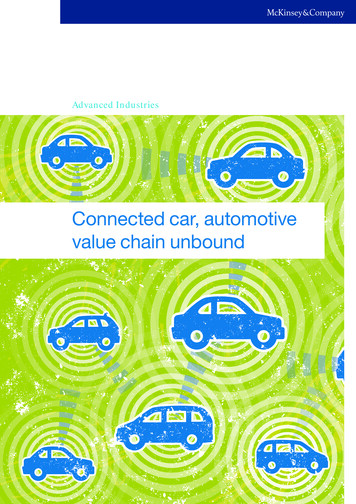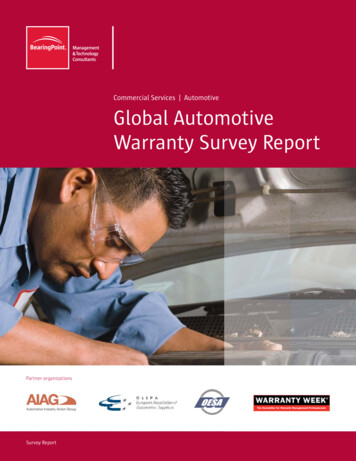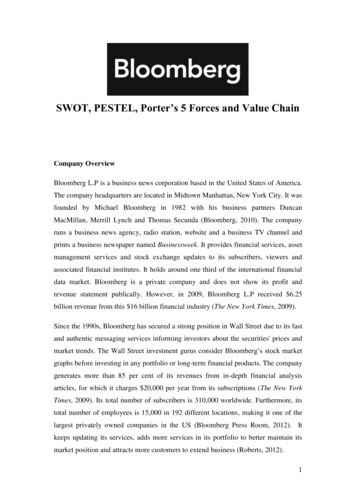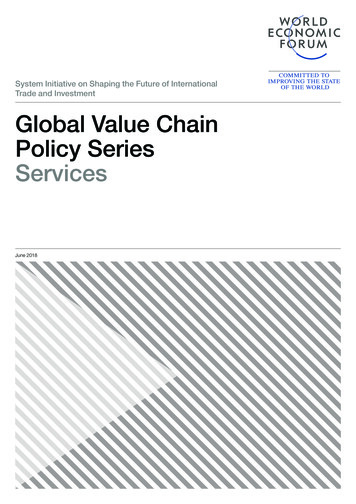
Transcription
Advanced IndustriesConnected car, automotivevalue chain unbound
Connected car, automotivevalue chain unbound
Contents4Executive summary. 71. Connectivity is on the rise and companies are establishing their roles along its value chain. 101.1Consumers demand connected car features but also indicate privacy concerns andlimited willingness to pay. 111.2 Cars are becoming increasingly “connected”. 131.3 Companies are repositioning themselves . 162. According to McKinsey’s market model, the global connected car market is likely to grow. 182.1 How McKinsey’s Connected Car Market Model works . 192.2 Global connected car market revenues are likely to increase sixfold until 2020 . 202.3 Overall car life cycle revenues are expected to remain stable. 213. Car connectivity is expected to trigger a redistribution of the five most importantautomotive revenue pools. 243.1 Vehicle price – connectivity has the potential to shift market shares between OEMs. 253.2 Connectivity hardware – OEM revenues may be at risk of being reduced or takenover by consumer electronics players. 263.3 Driver’s time and attention – OEMs will likely need to secure their share of usagebased revenues. 273.4 Maintenance – OEMs may have an opportunity to increase after-sales loyalty. 283.5 Insurance – as data and technology providers, OEMs may collect their shareof telematics-based insurance discounts . 294. Ability to monetize profit pools will depend on control points. 304.1 Delivery models and technology choices will significantly influence the distributionof future profit pools . 314.2 OEMs should focus on a set of key “differentiators” instead of competingfor all control points at once . 33
Connected car, automotive value chain unboundContents55. OEMs need to adapt across functions and consider new partnerships. 365.1 Adopting a decentralized and flexible structure can help OEMs respond to thedemands of a “connected” future . 375.2 Upgrading processes and governance can support OEMs’ internal functionsand external partnerships. 405.3 Industry standards and partnerships would likely be helpful to OEMs. 405.4 OEMs can learn from other industries that have already mastered the challenges of digitization . 416. Beyond 2020, autonomous driving will very likely trigger an industry-wide wave of disruption . 426.1 Autonomous driving has potential benefits for individual drivers as well as society as a whole. 436.2 Autonomous driving is expected to reach beyond automotive and transform adjacent industries . 446.3 Consumer, technology, and regulatory constraints will likely challenge the fulldeployment of (semi)autonomous vehicles . 44Conclusion. 46Appendix: McKinsey’s Connected Car Market Model methodology. 47Endnotes. 48Important notice. 50
Connected car, automotive value chain unboundExecutive summaryExecutive summary7The term “connected car”* is one of the most intensely debated buzzwords these days. There is no doubtthat it will shape the future of the automotive industry, but how? Are consumers going to pay for it (and whatis “it” anyway)? How will it impact the underlying revenue and profit pools? In addition, what will determinewho will benefit from changes in automotive profit pools?These are the questions we often hear from clients in the automotive, telecoms, technology, and insuranceindustries, among others, who are impacted by the connected car. We intend to address these questionsin this report. We have conducted significant primary market research with 2,000 car buyers across fourgeographies (see text box 1) and have built a pro prietary feature-level market model (see page 19) to separatefact from fiction and create a quantified understanding of value chain dynamics.There are manifold definitions that are used when referring to the connected car. In this report, we includeall use cases for passenger cars that build on processed information between vehicles and their environ ments. These use cases can be clustered along four relevant functional groups with particular relevanceto passenger cars – each with its own value proposition, set of affected players, and projected evolution:in-car content and services, vehicle relationship management (VRM), insurance, and driving assistance.In regard to a timeframe, the report focuses on the upcoming years until 2020. Therefore, it includesseveral significant innovations but excludes the next potential revolution, which is likely to result from amassive rollout of (semi)autonomous vehicles.As connectivity becomes an integral part of an automobile’s value, companies from industries that mayhave seemed unrelated to the automotive industry just a few years ago will likely become key players. As aconsequence, original equipment manufacturers (OEMs) and other traditional players may see shifts to theirpieces of a pie that is getting more complex but not necessarily significantly bigger.To get a comprehensive view on the impact of the connectedcar, we need to consider the consumer’s spend on a carin its entirety, the life cycle value. Based on a representativeGerman D-segment vehicle, today’s car life cycle revenuecan be broken down into its vehicle price (52 percent), connectivity features and services (4 percent),maintenance (6 per cent), insurance (14 percent), and operations (24 perc ent). By 2020, we expect theconnectivity-related revenues share to increase moderately to approximately 7 percent in the Europeanpremium car segment. This amounts to a global market size of EUR 170 billion to 180 billion for carconnectivity in 2020. However, we believe that this growth will be compensated by a base price decline,keeping life cycle spend more or less unchanged, just as it has remained since 1980.The global connected car market will grow, butoverall car life cycle revenues are expected toremain stable.Connectivity may trigger a significant redis tribu tion of all major automotive revenue pools exceptcar operations.The impact on revenue pools indirectly affected by connec tivity, such as vehicle price (through market share shifts)as well as insurance and maintenance, is much more sig nificant than the connectivity revenue pool itself.Vehicle price. On average, 20 percent of new car buyers state that they would switch to another carbrand for better connectivity features. In some regions and for some segments this share is even larger, forexample, up to 41 percent of drivers who spend more than 20 hours in the car per week. Hence, connec tivity has the potential to shift significant market shares between OEMs. The emergence of third-partyconnectivity offerings such as the Open Automotive Alliance (OAA) and Apple CarPlay may level the playingfield for infotainment and other software features among automotive OEMs.1* Connected car or car connectivity comprises the set of functions and capabilities that digitally links automobilesto drivers, services, and other automobiles. The various features serve to optimize vehicle operation and main tenance as well as driver comfort and convenience.
8Connectivity hardware. Higher rates of adoption will likely be offset by eroding feature prices, and OEMconnectivity hardware revenues are at risk of being reduced or taken over by consumer electronics players.Driver’s time and attention. We expect an uptake of app- and content-related revenues to about EUR 750over the life cycle, mainly through usage-based payment models. However, consumers will likely beloyal to their existing app/content ecosystems, thus limiting OEM participation to approximately 50 per cent, even in an optimistic scenario.Maintenance. Even after a typical 2-year warranty period, OEMs still capture a significant share of serviceand maintenance rev enues. Using car condition data is an opportunity for OEMs to increase loyalty. At thesame time, initial retrofit offers from third parties based on OBD-II dongles are already in the market. Today,23 percent of new car buyers state that they would follow app recommendations for maintenance; thistranslates to a potential for the redistribution of about EUR 450 in life cycle maintenance revenues.Insurance. Despite general privacy concerns, 35 percent of customers are already willing to trade drivingdata for insurance benefits. This creates an opportunity for OEMs to further tap into insurance revenuestreams through their access to driving data as well as for others to do the same through the OBD-II interface.We believe that connectivity has the potential to fundamen tally change the way in which profits are distributed in theautomotive value chain. In understanding upcoming dynam ics, we can derive learnings from industries that have gonethrough similar disruptions already, such as the mobilephone industry. For the mobile phone industry, the transition from feature phones to smart phonestriggered a redistribution of profits from hardware to software, with the key determining success factorsbeing the control of app stores and advertising platforms. We call these success factors control points.Applying this methodology to the automotive value chain, three major control points emerge:The human-machine inter face, car condition data,and dynamic real-time geoinforma tion will be come the key con trol points in the redistributionof profits.Human-machine interface (HMI). While lagging OEMs can make a step change in improving theircompeti tive ness by incorporating a third-party connectivity offering, leading OEMs will need alternativesources of differentiation in HMI, for example, even larger screens, multiple screens, innovative interfaceconcepts, and large-scale augmented reality experiences.Car condition data. Car condition data will be a key requirement for offering maintenance and insuranceservices. Although OEMs currently have privileged access to this data, third-party providers could convinceconsumers to install OBD-II dongles to create a superior user experience.Dynamic real-time geoinformation. Due to the effort required to maintain granular map data, this marketis increasingly becoming an oligopoly with only three major players on a global scale (TomTom, HERE, andGoogle). Access to granular map data will also become one of the critical enablers of (semi)autonomous driving.OEMs will need to adapt current processes and governanceacross functions, for exam ple, further reduce R&D life cycletimes for connectivity features (including over-the-air soft wareupdates for sold cars); build the big data IT-backbone uni f yingconsumer accounts as the basis for connectivity offers; and digitize mar ket ing and sales.Car connectivity will require fundamental changesto some of the core processes of automotiveOEMs as well as new partnerships.
Connected car, automotive value chain unboundExecutive summary9Moreover, a mindset shift from hardware make-or-buy decisions to software is essential when it comesto car con nec tivity. OEMs will have to carefully assess where to open up the car and provide platforms forthird-party innovations such as apps. Also, industry standards or even data infrastructure partnerships fornondifferentiating layers (for example, high-detail and dynamic map data) would help OEMs lower their R&Dinvestments and focus their efforts.On average, (semi)autonomous driving will free up one hourevery day for drivers and, thus, further fuel connectivity-relatedbusiness models, in particular with respect to media andcontent. Today, connectivity and advanced driver assistancesystems (ADAS) further advance the development of (semi)autonomous driving (for example, via granularmap data, regulation, cus tomer acceptance) and therefore help set the stage for future adoption.After 2020, (semi)autonomous driv ing will trigger
al ul se cases for passenger cars that bud oli n processed information between vehci el s and ther ei nvroi n - ments. These use cases can be cul stered aol ng four reel vant functional groups wtih particual r reel vance to passenger cars – each wtih its own vaul e propostiion, set of affected pal yers, and proej cted evoul tion: ni -car content and servci es, vehci e rl eal tionshp mi .











